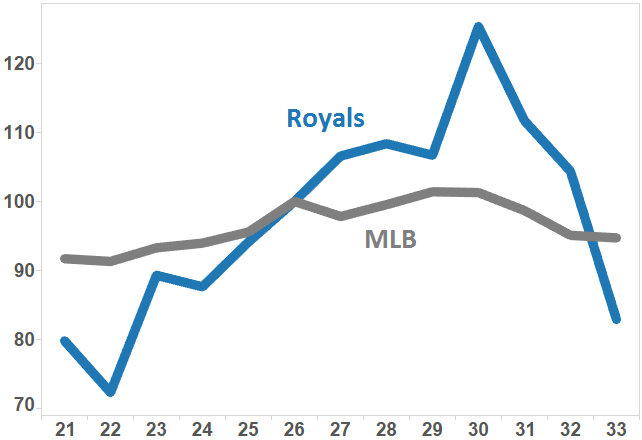KC’s Secret Sauce: Age-Defying Player Development
The 2006 Kansas City Royals went 62-100, tallying the team’s fourth 100-loss record in five years. In June of this particular season, owner David Glass hired a new general manager, Dayton Moore. ESPN’s first reaction was that Moore could have waited for the GM job with the Braves, who unlike the Royals were an “admired organization.” Jason Whitlock, who was in the midst of a 16-year stint as a writer for the Kansas City Star, declared that Moore was owner David Glass’ new scapegoat, and would soon be undermined by Glass’ “cheapness and incompetence.”
It took Dayton Moore a while to gain respect in Kansas City. In January of 2014, the last off-season that Moore’s Royals would endure without a World Series appearance, Royals Review mocked Moore’s tenure in Kansas City, which still only had one winning season.
Dayton Moore’s professional history before moving to Kansas City seemed to be the opposite of what a modern general manager was supposed to be. While the league’s front offices frantically shifted towards advanced statistics, Moore’s background was in scouting and player development. He established an excellent analytics office in the Royals’ organization, but his expertise and focus were drafting and signing promising young athletes and patiently developing the right type of team.
It worked, slowly. In 2009, they won 65 games. Then they won more in 2010 — and again in 2011, 2012, 2013, 2014, and 2015.
For six straight seasons, the Royals won more games than in the year before. They are the only team since World War II to do that. And they did it by being better than the rest of the league at exactly what Moore was supposed to do: develop talent.
In 2013, Jeff Zimmerman found that aging curves in baseball were changing. The fascinating and significant article showed that, in general, hitters no longer improved throughout their 20’s.
Dayton Moore’s Royals did not get the memo, and this may be what sets them apart from the rest of the league more than anything else. Sure, their bullpen is historically dominant. Yes, their solid and spectacular defense is remarkable. Their contact ability is extreme.
But all of these factors ignore something else that the Royals do historically well. Their hitters keep getting better, at points in their career when they are not supposed to.
From the ages of 23 to 26, Alex Gordon had a wRC+ of 93. That is not supposed to get better. From the age of 27 to 31, his wRC+ has been 123.
From the ages of 25 to 27, Lorenzo Cain had a wRC+ of 86. That is not supposed to get better. In his age 28 and 29 season, his wRC+ has been 121.
From the ages of 22 to 25, Mike Moustakas had a wRC+ of 82. This year, at age 26, it was 124.
This year, career 104 wRC+ hitter Eric Hosmer hit 125 at the age of 25.
Possibly most importantly for the 2015 team, Kendrys Morales followed up a 71 wRC+ season at the age of 31 with a 131 mark this year.
These players are not extremely old. None of them are at a point in their careers where they should be falling off a cliff, but recent history suggests that they should be stagnating, at best. But that’s not what the Royals have done.
Since Dayton Moore’s first full season in 2007, there have been plenty of mid-career surprises.
To create an aging curve, I measured the difference in wRC+ between consecutive seasons in which players had at least 300 PA. Then, I made every season relative to the performance at age 26, because that appears to be the first year of plateauing for the whole MLB. (Note: The results are not identical to Zimmerman’s).
From 2007-2015, with Age 26 being normalized to 100, here is what we get:

Royals players dramatically improve from their early 20’s all the way until they turn 30. While the sample size is not huge, the consist improvement is remarkable. Kansas City’s players show greater improvement than MLB average at age 25, 26, 27, 28, and 30. This feat is doubly difficult when you consider that a lucky season at age 27 should naturally show a decline at age 28.
Dayton Moore and the Royals organization are rightly being showered with praise after their second consecutive World Series appearance and their seemingly invincible run through the 2015 playoffs. But their formula of success is not a frozen-in-time snapshot of the 2015 team. Player production in one year does not define the strengths of the Royals organization. Rather, the possibility that it could be even better next year does.
Decent article – the Cardinals have also defied age as well.